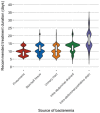Antibiotic treatment duration for bloodstream infections in critically ill children-A survey of pediatric infectious diseases and critical care clinicians for clinical equipoise
- PMID: 35881618
- PMCID: PMC9321425
- DOI: 10.1371/journal.pone.0272021
Antibiotic treatment duration for bloodstream infections in critically ill children-A survey of pediatric infectious diseases and critical care clinicians for clinical equipoise
Abstract
Objective: To describe antibiotic treatment durations that pediatric infectious diseases (ID) and critical care clinicians usually recommend for bloodstream infections in critically ill children.
Design: Anonymous, online practice survey using five common pediatric-based case scenarios of bloodstream infections.
Setting: Pediatric intensive care units in Canada, Australia and New Zealand.
Participants: Pediatric intensivists, nurse practitioners, ID physicians and pharmacists.
Main outcome measures: Recommended treatment durations for common infectious syndromes associated with bloodstream infections and willingness to enrol patients into a trial to study treatment duration.
Results: Among 136 survey respondents, most recommended at least 10 days antibiotics for bloodstream infections associated with: pneumonia (65%), skin/soft tissue (74%), urinary tract (64%) and intra-abdominal infections (drained: 90%; undrained: 99%). For central vascular catheter-associated infections without catheter removal, over 90% clinicians recommended at least 10 days antibiotics, except for infections caused by coagulase negative staphylococci (79%). Recommendations for at least 10 days antibiotics were less common with catheter removal. In multivariable linear regression analyses, lack of source control was significantly associated with longer treatment durations (+5.2 days [95% CI: 4.4-6.1 days] for intra-abdominal infections and +4.1 days [95% CI: 3.8-4.4 days] for central vascular catheter-associated infections). Most clinicians (73-95%, depending on the source of bloodstream infection) would be willing to enrol patients into a trial of shorter versus longer antibiotic treatment duration.
Conclusions: The majority of clinicians currently recommend at least 10 days of antibiotics for most scenarios of bloodstream infections in critically ill children. There is practice heterogeneity in self-reported treatment duration recommendations among clinicians. Treatment durations were similar across different infectious syndromes. Under appropriate clinical conditions, most clinicians would be willing to enrol patients into a trial of shorter versus longer treatment for common syndromes associated with bloodstream infections.
Conflict of interest statement
The authors have declared that no competing interests exist.
Figures



Similar articles
-
Antibiotic treatment duration for bloodstream infections in critically ill patients: a national survey of Canadian infectious diseases and critical care specialists.Int J Antimicrob Agents. 2011 Dec;38(6):480-5. doi: 10.1016/j.ijantimicag.2011.07.016. Epub 2011 Oct 7. Int J Antimicrob Agents. 2011. PMID: 21982833
-
Duration of antibiotic treatment and timing of oral switching for bloodstream infections: a survey on the practices of infectious diseases and intensive care physicians.Int J Antimicrob Agents. 2023 Jun;61(6):106802. doi: 10.1016/j.ijantimicag.2023.106802. Epub 2023 Apr 2. Int J Antimicrob Agents. 2023. PMID: 37015260
-
Duration of antibiotic therapy for bacteremia: a systematic review and meta-analysis.Crit Care. 2011;15(6):R267. doi: 10.1186/cc10545. Epub 2011 Nov 15. Crit Care. 2011. PMID: 22085732 Free PMC article. Review.
-
7 versus 14 days of antibiotic treatment for critically ill patients with bloodstream infection: a pilot randomized clinical trial.Trials. 2018 Feb 17;19(1):111. doi: 10.1186/s13063-018-2474-1. Trials. 2018. PMID: 29452598 Free PMC article. Clinical Trial.
-
Duration and cessation of antimicrobial treatment.J Hosp Med. 2012;7 Suppl 1:S22-33. doi: 10.1002/jhm.988. J Hosp Med. 2012. PMID: 23677632 Review.
Cited by
-
Fixed versus individualized treatment for five common bacterial infectious syndromes: a survey of the perspectives and practices of clinicians.JAC Antimicrob Resist. 2023 Aug 1;5(4):dlad087. doi: 10.1093/jacamr/dlad087. eCollection 2023 Aug. JAC Antimicrob Resist. 2023. PMID: 37533760 Free PMC article.
-
Noninferiority Margin Size and Acceptance of Trial Results: Contingent Valuation Survey of Clinician Preferences for Noninferior Mortality.Med Decis Making. 2022 Aug;42(6):832-836. doi: 10.1177/0272989X221099493. Epub 2022 May 18. Med Decis Making. 2022. PMID: 35583116 Free PMC article.
References
-
- Armenian SH, Singh J, Arrieta AC. Risk factors for mortality resulting from bloodstream infections in a pediatric intensive care unit. Pediatr Infect Dis J. 2005;24(4):309–14. doi: 10.1097/01.inf.0000157086.97503.bd . - DOI - PubMed
-
- Kumar A, Roberts D, Wood KE, Light B, Parrillo JE, Sharma S, et al.. Duration of hypotension before initiation of effective antimicrobial therapy is the critical determinant of survival in human septic shock. Crit Care Med. 2006;34(6):1589–96. doi: 10.1097/01.CCM.0000217961.75225.E9 . - DOI - PubMed
Publication types
MeSH terms
Substances
Grants and funding
LinkOut - more resources
Full Text Sources
Medical

